Stronger than Gas-Only Version
For 22 years and counting, Toyota’s RAV4 compact crossover has been a leader in its segment. All new for 2019, it offers gasoline-only and hybrid powertrains in several trims. I tested the sportiest version of the thriftiest one—the 2019 Toyota RAV4 Hybrid XSE all-wheel-drive model.
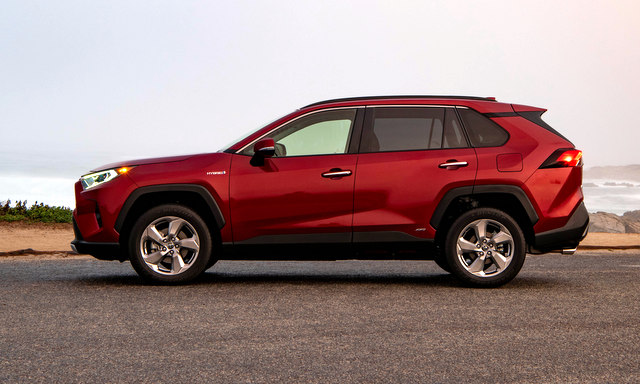
The fifth-generation 2019 Toyota RAV4 Hybrid has received the same jolt that the Camry and Corolla have—it stands out. The face mimics Toyota pickups with its tough, no-nonsense stance, and the wheelwells have an edginess that would make a Jeep proud. My dark blue “Blueprint/Midnight Black” example, with its black-painted 18-inch alloy wheels, was downright mean looking, especially in low light, when the pretty sparkles in the paint weren’t visible.
Toyota says the guiding themes were Adventure and Refined—seemingly very different, but it makes for more fun and a more finely crafted experience.
The Power & the Architecture
Powered by a 2.5-liter four-cylinder engine and a pair of electric motors (front and rear), the 2019 Toyota RAV4 Hybrid puts out a combined 219 net horsepower–more than the standard RAV4. Electric on-demand all-wheel drive and slightly higher ground clearance (8.6 inches) makes this one a good off-roader, if you’re willing to take it out there.
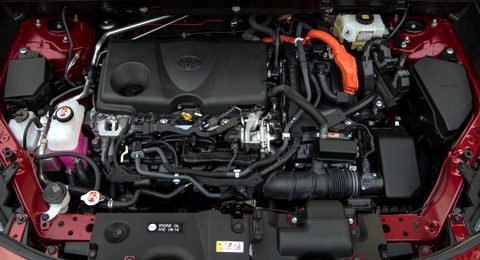
All RAV4s sit on the Toyota New Generation Architecture (TNGA) platform. It provides many benefits, the most notable being a more comfortable ride and more responsive handling. The 1.2-inch longer wheelbase (compared to the previous model) and wider front and rear tracks provide more stability, and shorter front and rear overhangs make negotiating tight off-road trails easier. The 57 percent more rigid unibody means no squeaks or rattles while climbing rocks, either.
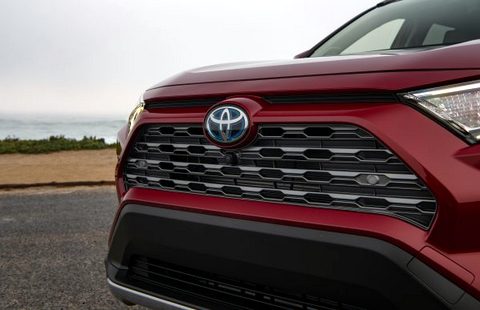
The TNGA platform places the powertrain lower in the structure, making the vehicle more stable, and the new parallel-type electric power steering is rack-mounted instead of column-mounted, for enhanced turning response and a more natural feel.
The all-wheel-drive system in the RAV4 Hybrid mounts a separate rear electric motor, which drives the rear wheels when needed. Total torque is up 30 percent from the previous model. Predictive Efficient Drive (PED) monitors your driving patterns to optimize hybrid battery charging. It gathers data and records features like hills and stoplights and adjusts the hybrid powertrain. That’s smart.
The Numbers Delivered
EPA numbers for the 3,755-pound compact crossover SUV are 41 mpg city/38 highway/40 combined. I averaged 37.1 mpg during my test week. The Combined number for gas-only models is 30, so there’s a significant difference when you opt for the Hybrid. Green numbers sit at 7 for smog and an exemplary 9 for Greenhouse Gas. Its 223 grams of CO2 per mile is about half the emissions of a “regular” car.
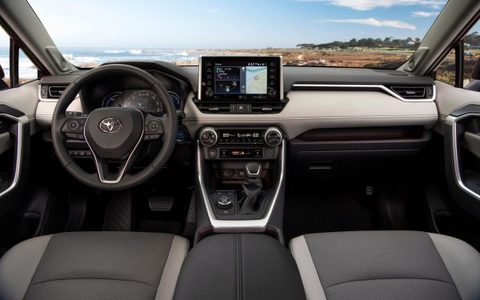
Inside, the new RAV4 sports an angular dash and doors, with ruggedness conveyed by tactile rubber on the inside of the door pulls and the dials on the audio system (easy to use with gloves on, too). Billet-style metallic accents and padded dash look classy. The dash sits lower, for better visibility. The seats are redesigned to be more supportive and comfortable.
You know you’re in a truck, with upright shapes and a high headliner, but driving the RAV4 is entertaining and comfortable. The standard Entune 3.0 audio system includes SiriusXM Radio and, finally, Apple CarPlay! Oddly, Android Auto is not available.
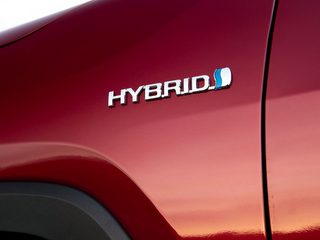
Like the many other hybrids Toyota sells, this one gives you some information on the dash about how you’re driving. The dial shows when you’re generating electricity (slowing down and braking), using electricity (during acceleration and climbing hills) and just cruising along. The goal is to encourage deliberate, economical motoring, but you know a vehicle like this is sometimes going to be used just for fun. The Drive Mode setting lets you choose responsible Eco, everyday Normal or exciting Power. So, go ahead and pick the Power setting for a little while—it’ll drop your efficiency numbers a bit, but you’ll still be mostly a good citizen.
Lots of Good Choices
The Hybrid model comes in four trim grades: LE, XLE, XSE and Limited. My XSE model—the sportiest of the bunch—flaunted a sport-tuned suspension with tauter springs and shock absorbers. The thing will shoot from 0-to-60 in just 7.8 seconds, too.
You don’t need to spend a lot more to drive home the Hybrid model. The base LE is $25,500 for the gas front-wheel drive model and $27,700 for the Hybrid. My XSE Hybrid started at $33,700, but with some significant options, topped out at $37,899.
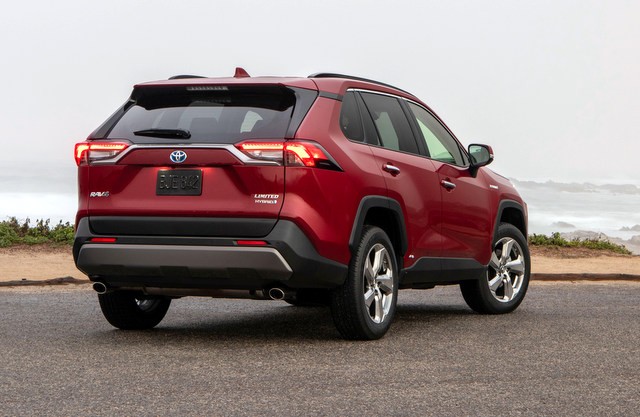
Toyota is “the hybrid car company” and the RAV4, already a hit (for the first six months of 2019 the RAV4 is the best-selling Toyota model—car or truck—in the U.S.), is a more responsible choice when you drop in the electric motors. In this case, the hybrid is more powerful than the gas version. It’s hard to imagine that it won’t just get more popular. An all-electric RAV4 isn’t likely anytime soon, but you never know (it has happened twice before, albeit in limited numbers).
Make sure to opt-in to the Clean Fleet Report newsletter (top right of page) to be notified of all new stories and vehicle reviews.
Related Stories You Might Enjoy—Compact SUV Choices
The choices run the gamut from battery electric and fuel cell electric models to a variety of plug-in hybrid, hybrid and gas configurations with differing approaches to what the small SUV buyer is looking for. Some of these models are going away, some may not be here yet, so choose carefully.
News: 2020 Ford Escape Adds Plug-in Hybrid
Flash Drive: 2020 Hyundai Nexo FCEV
Road Test: 2019 Hyundai Santa Fe
Road Test: 2019 Subaru Outback PHEV
Flash Drive: 2019 Jeep Cherokee
Road Test: 2017 Jeep Cherokee
News: Jeep Compass Goes Plug-in Hybrid
Road Test: 2019 Hyundai Kona EV
Road Test: 2018 Hyundai Kona (Gas)
Road Test: 2019 Mitsubishi Outlander PHEV
Road Test: 2018 Honda CR-V
Road Test: 2018 Mazda CX-5
Road Test: 2018 Mitsubishi Eclipse Cross
Road Test: 2018 Mitsubishi Outlander Sport
Flash Drive: 2018 GMC Terrain
Road Test: 2018 Volkswagen Tiguan
Road Test: 2017 Nissan Rogue Hybrid
Road Test: 2018 Nissan Rogue
Road Test: 2014 Subaru Forester
Road Test: 2017 Hyundai Tucson FCEV
Road Test: 2018 Chevrolet Equinox Diesel
Road Test: 2018 Kia Sportage
Disclosure:
Clean Fleet Report is loaned free test vehicles from automakers to evaluate, typically for a week at a time. Our road tests are based on this one-week drive of a new vehicle. Because of this we don’t address issues such as long-term reliability or total cost of ownership. In addition, we are often invited to manufacturer events highlighting new vehicles or technology. As part of these events we may be offered free transportation, lodging or meals. We do our best to present our unvarnished evaluations of vehicles and news irrespective of these inducements.
Our focus is on vehicles that offer the best fuel economy in their class, which leads us to emphasize electric cars, plug-in hybrids, hybrids and diesels. We also feature those efficient gas-powered vehicles that are among the top mpg vehicles in their class. In addition, we aim to offer reviews and news on advanced technology and the alternative fuel vehicle market. We welcome any feedback from vehicle owners and are dedicated to providing a forum for alternative viewpoints. Please let us know your views at publisher@cleanfleetreport.com.

30 thoughts on “Road Test: 2019 Toyota RAV4 Hybrid”